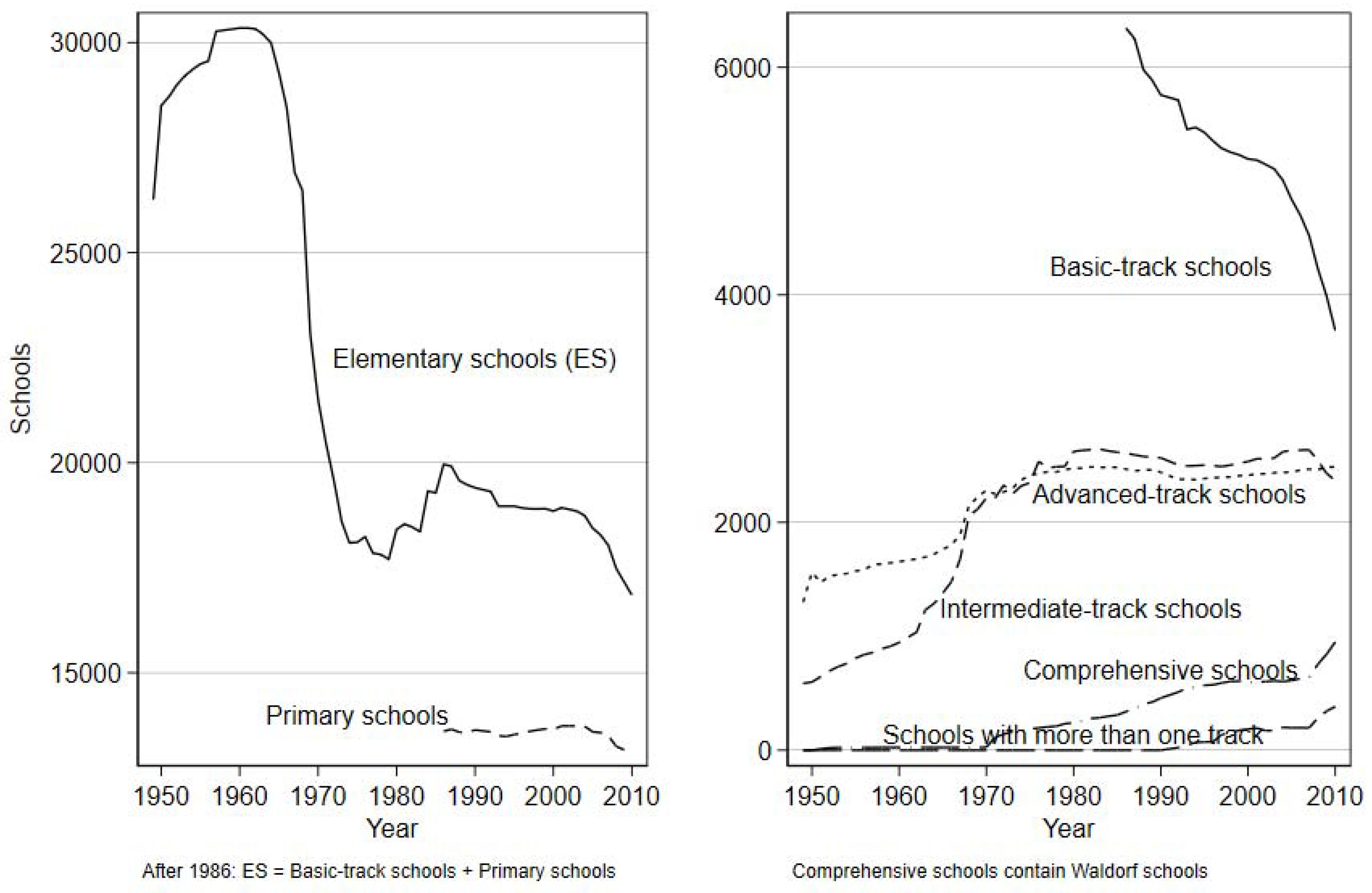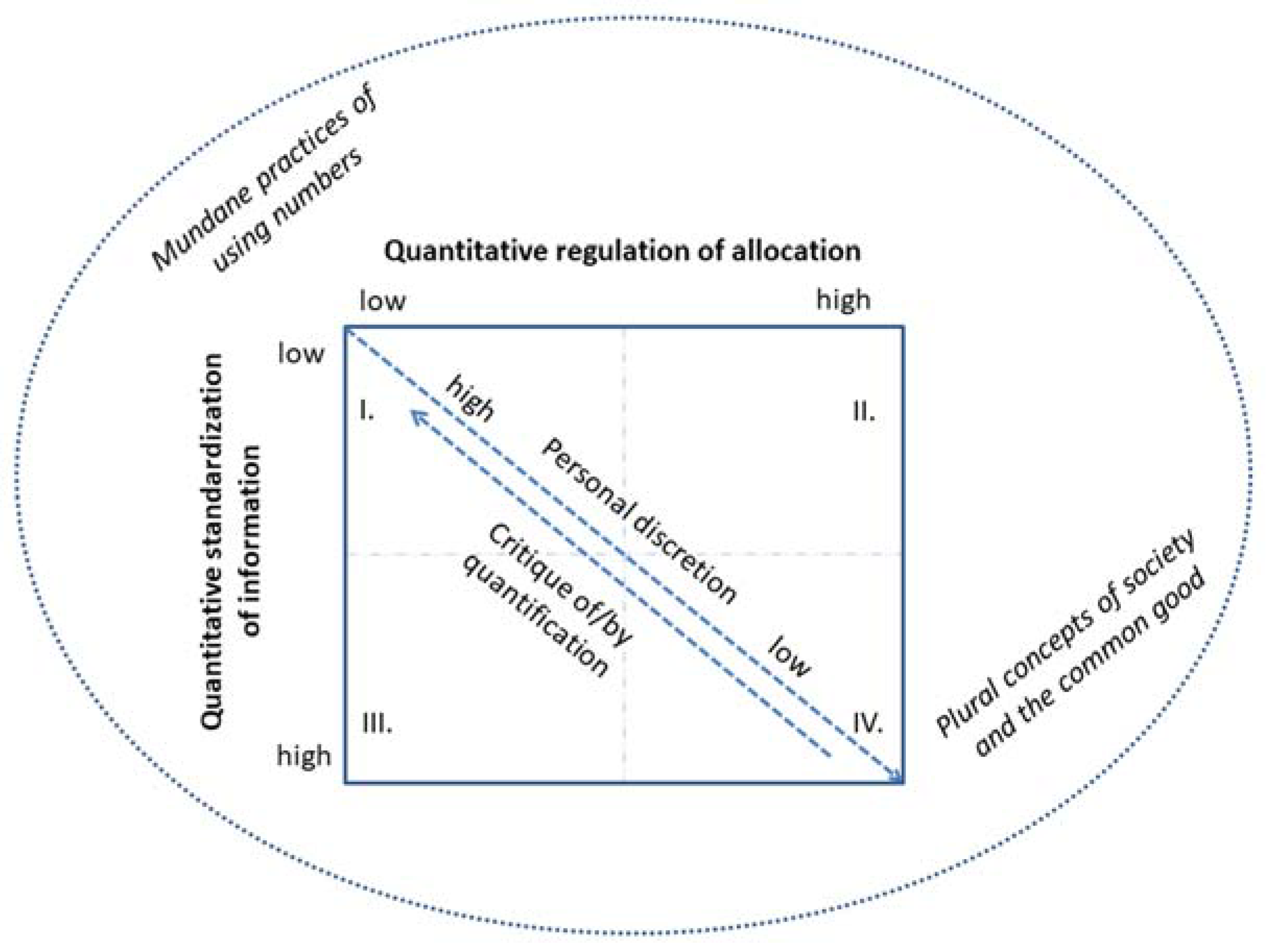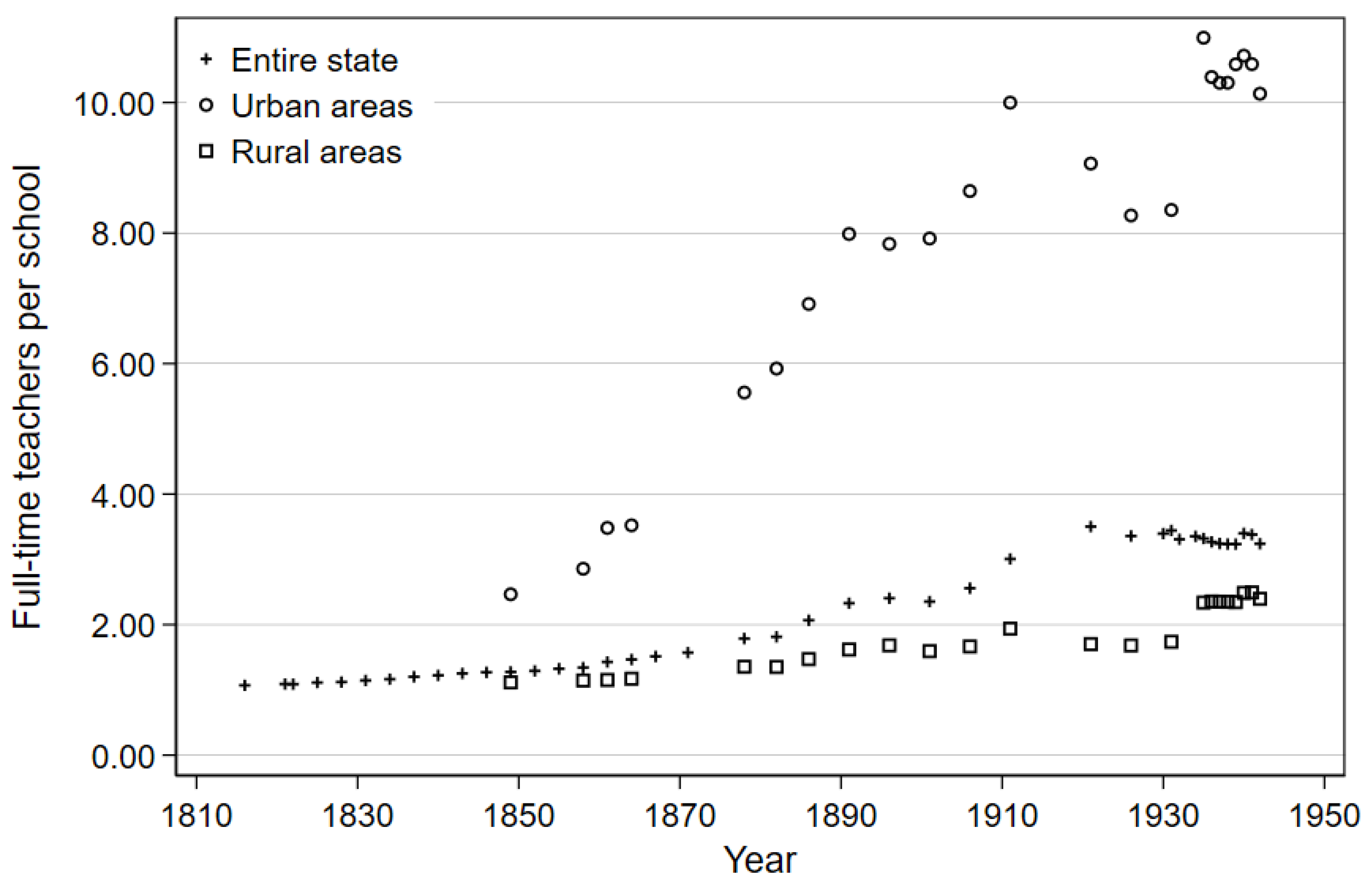Governing Spatial Disparities in School Infrastructure by Numbers: Investments in Form, Tensions, New Compromises?
Abstract
:1. Introduction
2. Governing by Numbers and Spatial Disparities in Schooling
2.1. Spatial Disparities in Schooling, Education Monitoring, and School Planning: Varying Roles of Numbers and Missing Links
2.2. Decision Making Based on Indicators: Information, (E)Valuation, Allocation
2.3. Using Indicators to Construct and Constitute Spatial Disparities in School Infrastructure
2.4. Distinguishing between Different forms of Governing by Indicators
3. Governing Spatial Disparities of School Infrastructure by Numbers in Germany
3.1. Discretionary School Policy and Limited Investments in Quantification
3.1.1. Allocating School Infrastructure Resources through Discretionary and Bureaucratic Quantification
3.1.2. Limited Investments in Measuring Spatial Disparities in Schooling
3.1.3. Little Instrumental Connection between Measuring Spatial Disparities and the Spatial Allocation of School Resources
3.2. The Decentralized Institutionalization of Calculative Quantification in School Planning
3.2.1. Investments in Centralized National Education Planning and Its Failure
3.2.2. Decentralized School Planning as a Calculative Governance Device
3.2.3. Tensions and Compromises

4. Discussion
Funding
Institutional Review Board Statement
Informed Consent Statement
Data Availability Statement
Acknowledgments
Conflicts of Interest
References
- Heidenreich, M. Regionale Muster von Bildungsarmut. In Handbuch Bildungsarmut; Quenzel, G., Hurrelmann, K., Eds.; Springer: Wiesbaden, Germany, 2019; pp. 29–38. ISBN 978-3-658-19572-4. [Google Scholar]
- Sixt, M.; Rossen, A.; Fuchs, S. Immer noch Bildungsnotstandsgebiete? In Handbuch Bildungsarmut; Quenzel, G., Hurrelmann, K., Eds.; Springer: Wiesbaden, Germany, 2019; pp. 121–155. ISBN 978-3-658-19572-4. [Google Scholar]
- Löw, M. In Welchen Räumen Leben Wir? Eine Raumsoziologisch Und Kommunikativ Konstruktivistische Bestimmung Der Raumfiguren Territorialraum, Bahnenraum, Netzwerkraum Und Ort. In Grenzen der Kommunikation—Kommunikation an den Grenzen; Reichertz, J., Eickhoff, J., Eds.; Velbrück Wissenschaft: Weilerswist, Germany, 2020; pp. 149–164. ISBN 3-95832-199-2. [Google Scholar]
- Seitzer, H.; Besche-Truthe, F.; Windzio, M. Networks of Global Policy Diffusion: The Introduction of Compulsory Education. In Networks and Geographies of Global Social Policy Diffusion: Culture, Economy, and Colonial Legacies; Windzio, M., Mossig, I., Besche-Truthe, F., Seitzer, H., Eds.; Springer: Berlin/Heidelberg, Germany, 2022; pp. 59–81. ISBN 978-3-030-83403-6. [Google Scholar]
- Meyer, J.W.; Rubinson, R. Education and Political Development. Rev. Res. Educ. 1975, 3, 134–162. [Google Scholar]
- Normand, R. The Changing Epistemic Governance of European Education: The Fabrication of The Homo Academicus Europeanus? Springer: Berlin/Heidelberg, Germany, 2016; ISBN 978-3-319-31774-8. [Google Scholar]
- Bildungsberichterstattung, A. Bildung in Deutschland 2018: Ein Indikatorengestützter Bericht Mit Einer Analyse zu Wirkungen und Erträgen von Bildung; wbv: Bielefeld, Germany, 2018. [Google Scholar]
- Brüggemann, C. Datenbasiertes Bildungsmanagement als Steuerungsversprechen der Regionalisierungspolitik im Bildungswesen. Z. Für Pädagogik 2021, 67, 338–352. [Google Scholar]
- van Dooren, W.; Bouckaert, G.; Halligan, J. Non-use. Performance Management in The Public Sector, 2nd ed.; Routledge: London, UK, 2015; pp. 154–173. [Google Scholar]
- Hartong, S.; Förschler, A. Opening the black box of data-based school monitoring: Data infrastructures, flows and practices in state education agencies. Big Data Soc. 2019, 6, 1–12. [Google Scholar] [CrossRef]
- Caven, M. Quantification, Inequality, and the Contestation of School Closures in Philadelphia. Sociol. Educ. 2018, 37, 21–40. [Google Scholar] [CrossRef]
- Ares Abalde, M. School Size Policies: A Literature Review; OECD Education Working Papers No. 106; OECD Education: Paris, France, 2014. [Google Scholar]
- Bartl, W.; Sackmann, R. Governance Indicators and Responsiveness to Population Decline: School Closure as Practice and Discourse in Saxony-Anhalt. Comp. Popul. Stud. 2016, 41, 321–358. [Google Scholar] [CrossRef]
- Walde, A. Schulpolitik in Städten mit Schülerrückgang. Eine Governance-Analyse am Beispiel von Leipzig und Timişoara; Springer: Wiesbaden, Germany, 2019. [Google Scholar]
- Kann, C. Schulschließungen und Umbau von Schulstandorten: Steuerungsansätze bei sinkenden Schülerzahlen und die Rolle der Privatschulen; Springer: Wiesbaden, Germany, 2017. [Google Scholar]
- Lehtonen, M. Indicators: Tools for Informing, Monitoring or Controlling? In The Tools of Policy Formulation; Jordan, A., Turnpenny, J., Eds.; Elgar: Cheltenham, UK, 2015; pp. 76–99. ISBN 9781783477043. [Google Scholar]
- Desrosières, A. The Politics of Large Numbers: A History of Statistical Reasoning; Harvard University Press: Cambridge, MA, USA, 1998; ISBN 0-674-68932-1. [Google Scholar]
- Desrosières, A. Words and Numbers. For a Sociology of the Statistical Argument. In The Mutual Construction of Statistics and Society; Sætnan, A.R., Lomell, H.M., Hammer, S., Eds.; Routledge: New York, NY, USA, 2011; pp. 41–63. ISBN 0-415-87370-3. [Google Scholar]
- Thévenot, L. Rules and implements: Investment in forms. Soc. Sci. Inf. 1984, 23, 1–45. [Google Scholar] [CrossRef]
- Thévenot, L. Measure for Measure: Politics of Quantifying Individuals to Govern Them. Hist. Soc. Res. 2019, 44, 44–76. [Google Scholar] [CrossRef]
- Latour, B. Science in Action: How to Follow Scientists and Engineers Through Society; Harvard University Press: Cambridge, MA, USA, 1987; ISBN 9780674792913. [Google Scholar]
- Heintz, B. Zahlen, Wissen, Objektivität: Wissenschaftssoziologische Perspektiven. In Zahlenwerk. Kalkulation, Organisation, Gesellschaft; Mennicken, A., Vollmer, H., Eds.; VS Verlag für Sozialwissenschaften: Wiesbaden, Germany, 2007; pp. 65–86. [Google Scholar]
- Bartl, W.; Papilloud, C.; Terracher-Lipinski, A. Governing by Numbers: Key Indicators and the Politics of Expectations. An Introduction. Hist. Soc. Res. 2019, 44, 7–43. [Google Scholar] [CrossRef]
- Porter, T.M. Trust in Numbers: The Pursuit of Objectivity in Science and Public Life; Princeton University Press: Princeton, NJ, USA, 1995; ISBN1 0-691-02908-3. ISBN2 0-691-03776-0. [Google Scholar]
- Espeland, W.N. Authority by the numbers: Porter on quantification, discretion, and the legitimation of expertise. Law Soc Inq 1997, 22, 1107–1133. [Google Scholar] [CrossRef]
- Espeland, W.; Stevens, M.L. Commensuration as a Social Process. Annu. Rev. Sociol. 1998, 24, 313–343. [Google Scholar] [CrossRef] [Green Version]
- Rose, N.S. Numbers. Powers of Freedom. Reframing Political Thought; Cambridge University Press: Cambridge, UK, 1999; pp. 197–232. ISBN 9780521659055. [Google Scholar]
- Waibel, D.; Peetz, T.; Meier, F. Valuation Constellations. Valuat. Stud. 2021, 8, 33–66. [Google Scholar] [CrossRef]
- Starr, P. The Sociology of Official Statistics. In The politics of numbers; Alonso, W., Starr, P., Eds.; Russell Sage Foundation: New York, NY, USA, 1987; pp. 7–57. ISBN 0-87154-015-0. [Google Scholar]
- Emigh, R.J. Numeracy or Enumeration? The Uses of Numbers by States and Societies. Soc. Sci. Hist. 2002, 26, 653–698. [Google Scholar] [CrossRef]
- Bruno, I.; Didier, E.; Vitale, T. Statactivism. Forms of action between disclosure and affirmation. Partecip. E Confl. 2014, 4, 198–220. [Google Scholar]
- Christmann, G.B. Kommunikative Raumkonstruktionen als (Proto-)Governance. In Governance und Raum; Kilper, H., Ed.; Nomos: Baden-Baden, Germany, 2010; pp. 27–48. ISBN 978-3-8452-2625-5. [Google Scholar]
- Barlösius, E. Infrastrukturen als soziale Ordnungsdienste: Ein Beitrag zur Gesellschaftsdiagnose; Campus: Frankfurt (Main), Germany, 2019; ISBN 3593510898. [Google Scholar]
- Mann, M. The autonomous power of the state: Its origins, mechanisms and results. Eur. J. Sociol. 1984, 25, 185–213. [Google Scholar] [CrossRef]
- Thévenot, L. Organized Complexity: Conventions of Coordination and the Composition of Economic Arrangements. Eur. J. Soc. Theory 2001, 4, 405–425. [Google Scholar] [CrossRef]
- Boltanski, L.; Thévenot, L. On Justification: Economies of Worth; Princeton University Press: Princeton, NJ, USA, 2006; ISBN 9780691125169. [Google Scholar]
- Derouet, J.-L. Lower Secondary Education in France: From Uniformity to Institutional Autonomy. Eur. J. Educ. 1991, 26, 119–132. [Google Scholar] [CrossRef]
- Leemann, R.J.; Imdorf, C. Das Potenzial der Soziologie der Konventionen für die Bildungsforschung. In Bildung und Konventionen: Die „Economie des Conventions“ in der Bildungsforschung; Imdorf, C., Leemann, R.J., Gonon, P., Eds.; Springer: Wiesbaden, Germany, 2019; pp. 3–45. ISBN 978-3-658-23301-3. [Google Scholar]
- Boltanski, L.; Chiapello, E. The New Spirit of Capitalism; Verso: New York, NY, USA, 2007. [Google Scholar]
- Sackmann, R. Mechanismen der Elitebildung: Theoretisches Konzept und empirische Trends im deutschen Bildungssystem und im internationalen Vergleich. Z. Für Pädagogik 2019, 65, 41–60. [Google Scholar]
- Barton, A. The Concept of Property-Space in Social Research. In The Language of Social Research, 2nd ed.; Lazarsfeld, P.F., Rosenberg, M., Eds.; The Free Press: New York, NY, USA, 1957; pp. 40–53. [Google Scholar]
- Helbig, M.; Nikolai, R. Die Unvergleichbaren. Der Wandel der Schulsysteme in den deutschen Bundesländern seit 1949; Klinkhardt: Bad Heilbrunn, Germany, 2015. [Google Scholar]
- Nath, A.; Titze, H.; Dartenne, C.M.; Kasel, G.; Oelerich-Sprung, C.; Schmeitzner, K.; Wloch, H.; Griebel, A.; Kneisler, T.; Kirste, I. Differenzierung und Integration der niederen Schulen in Deutschland 1800–1945; Vandenhoeck & Ruprecht: Göttingen, Germany, 2016; ISBN 978-3-525-36213-6. [Google Scholar]
- Dupuy, C. Converging Regional Education Policy in France and Germany; Palgrave: Cham, Germany, 2020. [Google Scholar]
- Malan, T. Educational Planning as a Social Process; No. 33; Fundamentals of Educational Planning: Paris, France, 1987. [Google Scholar]
- Köhler, H. Amtliche Bildungsstatistik im Wandel. In Gegenwärtige Probleme; Bildungsbericht, P., Ed.; Rowohlt: Reinbek bei Hamburg, Germany, 1980; pp. 1215–1285. ISBN 3-499-17338-7. [Google Scholar]
- Barlösius, E. Die Macht der Repräsentation: Common Sense über Soziale Ungleichheiten; VS Verlag für Sozialwissenschaften: Wiesbaden, Germany, 2005; ISBN 978-3-531-14640-9. [Google Scholar]
- Ringel, L.; Werron, T. Serielle Vergleiche: Zum Unterschied, den Wiederholung macht. Köln Z Soziol 2021, 73, 301–331. [Google Scholar] [CrossRef]
- Klemm, K.; Kneuper, D. Zur Orientierung von Schulausgaben an Sozialindizes—Ein Bundesländervergleich. Available online: http://library.fes.de/pdf-files/studienfoerderung/15755.pdf (accessed on 25 February 2022).
- Bartl, W. Why do Municipalities ‘Think’ in Demographic Terms? Governing by Population Numbers in Germany and Poland. Coping with Demographic Change. A Comparative View on Education and Local Government in Germany and Poland; Springer: Dordrecht, The Netherlands, 2015; pp. 67–94. ISBN 9783319103013. [Google Scholar]
- Prenzel, P.V. Regional Consequences of Demographic Change: Regional Development and Disparities in a Context of Ageing and Shrinking Population in Germany. Ph.D. Thesis, London School of Economics and Political Science, London, UK, 2017. [Google Scholar]
- Wehler, H.U. Von der Reformära bis zur industriellen und politischen “Deutschen Doppelrevolution” 1815–1845/49; Beck: München, Germany, 2008; ISBN 340632262X. [Google Scholar]
- Matzerath, H. Urbanisierung in Preußen 1815-1914; Kohlhammer: Stuttgart, Germany, 1985. [Google Scholar]
- Budde, G. From the ‘Zwergschule’ (One-Room Schoolhouse) to the Comprehensive School: German Elementary Schools in Imperial Germany and the Weimar Republic, 1870–1930. In Mass Education and the Limits of State Building, c.1870–1930; Brockliss, L., Sheldon, N., Eds.; Palgrave: London, UK, 2012; pp. 95–116. ISBN 978-0-230-37021-0. [Google Scholar]
- Neugebauer, W. Absolutistischer Staat und Schulwirklichkeit in Brandenburg-Preußen; de Gruyter: Berlin, Germany, 1985; ISBN 3110099209. [Google Scholar]
- Heinemann, M. Schule im Vorfeld der Verwaltung. Die Entwicklung der preußischen Unterrichtsverwaltung von 1771–1800; Vandenhoeck & Ruprecht: Göttingen, Germany, 1974. [Google Scholar]
- Herrmann, U.G. Schulplanung und Schulentwicklung in den Provinzen des Staates Preußen, 1890–1914. Regionale Differenzierung und gesamtstaatliche Systembildung: Preußen und seine Provinzen—Deutsches Reich und seine Staaten. 1800–1945; Vandenhoeck & Ruprecht: Göttingen, Germany, 2003; pp. 75–159. ISBN 3-525-36212-9. [Google Scholar]
- Rademacher, B. Zentralisierung und Dezentralisierung: Zur Genese der Schulverwaltung in der Konstitutionsphase der Bürgerlichen Gesellschaft, Dargestellt am Beispiel Preußens; Klinkhardt: Bad Heilbrunn, Germany, 1978; ISBN 3-7815-0382-8. [Google Scholar]
- Roeder, P.M. Gemeindeschule in Staatshand: Zur Schulpolitik des Preußischen Abgeordnetenhauses. Z. Für Pädagogik 1966, 12, 539–569. [Google Scholar]
- Leschinsky, A.; Roeder, P.M. Schule im Historischen Prozeß: Zum Wechselverhältnis von Institutioneller Erziehung und Gesellschaftlicher Entwicklung; Klett: Stuttgart, Germany, 1976; ISBN 3-12-926970-3. [Google Scholar]
- Klewitz, M. Preußische Volksschule vor 1914. Zur regionalen Auswertung der Schulstatistik. Z. Für Pädagogik 1981, 27, 551–573. [Google Scholar]
- Tredup, A.E. Statistik des deutschen Schulwesens: Historisch methodologische Untersuchung der Schulstatistik in den 5 grösseren Bundesstaaten seit Reichsgründung und der Reichsschulstatistik. All. Stat. Arch. 1923, 14, 1–81. [Google Scholar]
- Titze, H. Historische Bildungsstatistik 1800 bis 1945. In Historische Statistik in der Bundesrepublik Deutschland; Statistisches Bundesamt: Wiesbaden, Germany, 1990; pp. 65–89. [Google Scholar]
- Ficker, A. Schulstatistik. In Schule—Sophisten der Römischen Kaiserzeit; Schmid, K.A., Ed.; Besser: Gotha, Germany, 1870; pp. 243–281. [Google Scholar]
- Der Minister der Geistlichen, Unterrichts- und Medizinalangelegenheiten. Allgemeine Bestimmungen über das Preußische Volksschul-, Präparanden- und Seminar-Wesen vom 15. Oktober 1872, 9th ed.; Heuser: Neuwied, Germany, 1887.
- Lenhardt, G.; Stock, M. Bildung, Bürger, Arbeitskraft: Schulentwicklung und Sozialstruktur in der BRD und der DDR.; Suhrkamp: Frankfurt (Main), Germany, 1997; ISBN 978-3-518-28921-1. [Google Scholar]
- Hüfner, K.; Naumann, J. Der Aufschwung (1960–1967); Klett: Stuttgart, Germany, 1977; ISBN 3-12-923940-5. [Google Scholar]
- Coombs, P.H. Educational Planning; A Directory of Training and Research Institutions; UNESCO-IIEP: Paris, France, 1968. [Google Scholar]
- Ferrez, J. Regional Inequalities in Educational Opportunity. In Ability and Educational Opportunity; Halsey, A.H., Ed.; OECD: Paris, France, 1961; pp. 69–87. [Google Scholar]
- Diederich, J. Die Landschulreform im Spiegel der Pädagogischen Zeitschriften; Beltz: Weinheim, Germany, 1967. [Google Scholar]
- Bormann, M. Bildungsplanung in der Bundesrepublik Deutschland: System und Grundlagen; Westdeutscher Verlag: Opladen, Germany, 1978; ISBN 978-3-531-11449-1. [Google Scholar]
- KMK. Bedarfsfeststellung 1961 bis 1970 für Schulwesen, Lehrerbildung, Wissenschaft und Forschung, Kunst und Kulturpflege; Klett: Stuttgart, Germany, 1963. [Google Scholar]
- Deutscher Bundestag. Unterrichtung Durch die Bundesregierung: Bildungsgesamtplan; Drucksache 7/1474: Bonn, Germany, 1973. [Google Scholar]
- Rolff, H.G.; Klemm, K.; Hansen, G. Die Stufenschule: Ein Leitfaden zur Kommunalen Schulentwicklungsplanung; Klett: Stuttgart, Germany, 1974; ISBN 3-12-926950-9. [Google Scholar]
- Heinz, R.; Schier, M.-L. Schulentwicklungsplanung vor Verabschiedung des Bildungsgesamtplans. Eine Auswertung kommunaler Pläne; Arbeiststelle für Schulentwicklungsforschung (AFS): Dortmund, Germany, 1974. [Google Scholar]
- Wagener, F. Neubau und Verwaltung. Gliederung der öffentlichen Aufgaben und ihrer Träger nach Effektivität und Integrationswert, 2nd ed.; Duncker & Humblot: Berlin, Germany, 1974. [Google Scholar]
- Arneth, G. Schulentwicklungsplanung im Rahmen regionaler Strukturplanung. Z. Für Pädagogik 1972, 18, 829–850. [Google Scholar]
- Schulz, D. Pädagogisch Relevante Dimensionen Konkurrierender Schulentwicklungsplanung: Bestandsaufnahme und Qualitative Analyse der Schulentwicklungsplanung in den Ländern der Bundesrepublik Deutschland; Lang: Frankfurt (Main), Germany, 1981; ISBN 3-8204-6942-7. [Google Scholar]
- Rauch, N.; Schröder, T. Zur Methodik der Schulentwicklungsplanung. Gesamtschulen: Informationsdienst, Nachrichten, Berichte, Bibliographen, Dokumente 1970, 3, 31–50. [Google Scholar]
- Deutscher Städtetag. Hinweise zur Schulentwicklungsplanung; Deutscher Städtetag: Köln, Germany, 1972. [Google Scholar]
- Kommunale Gemeinschaftsstelle. Organisation der Schulentwicklungsplanung; KGSt-Bericht 10/1975: Köln, Germany, 1975. [Google Scholar]
- Martinsen, R.; Back, H.-J.; Schultze, H.-D. Regionale Schulentwicklungsplanung: Grundlagen, Methoden, Realisierung; Forum-Verlag: Stuttgart, Germany, 1974. [Google Scholar]
- Brixner, W. Universität Tübingen, Tübingen, Germany, 1972.
- Furck, C.-L. Neue Dimensionen in den Schulentwicklungsplänen? Z. Für Pädagogik 1972, 18, 803–828. [Google Scholar]
- Schütz, P.; Schütze, A. Schulentwicklungsplanung: Eine neue Chance für Reformen? Bild. Und Erzieh. 1975, 28, 348–356. [Google Scholar] [CrossRef]
- Bartl, W.; Papilloud, C. Measuring “equivalent living conditions”? The use of indicators in German federal spatial planning. Stat. J. IAOS 2020, 36, 375–399. [Google Scholar] [CrossRef]
- Russig-Kallfass, S. Handlungsspielräume Kommunaler Schulentwicklungsplanung: Zur Theorie und Praxis Dezentraler Schulpolitik; Beltz: Weinheim, Germany, 1977; ISBN 3-407-58003-7. [Google Scholar]
- Böttcher, W.; Budde, H.; Klemm, K.; Meergans, H. Schulentwicklungsplanung: Eine Handreichung für die Neuen Länder; Max-Traeger-Stiftung: Frankfurt (Main), Germany, 1992. [Google Scholar]
- Wenk, S. Das Ringen um die “Wirklichkeit der Dorfschule” und die Reform des ländlichen Schulwesens in den 1960er Jahren. In Wissen Machen: Beiträge zu Einer Geschichte Erziehungswissenschaftlichen Wissens in Deutschland Zwischen 1945 und 1990; Reh, S., Glaser, E., Behm, B.L., Drope, T., Behm, B., Eds.; Beltz Juventa: Weinheim, Germany, 2017; pp. 143–163. ISBN 3-7799-3516-3. [Google Scholar]
- Aurin, K. Regionale Schulplanung unter veränderten Bedingungen: Probleme, Forschungsaufgaben und neue Planungsorientierungen. In Regional Differenzierte Schulplanung unter Veränderten Verhältnissen: Probleme der Erhaltung und Strukturellen Weiterentwicklung Allgemeiner und Beruflicher Bildungseinrichtungen; Aurin, K., Ed.; Vincentz: Hannover, Germany, 1984; pp. 9–24. ISBN 3-87870-753-3. [Google Scholar]
- Trotha, T.V. Sicherung einer wohnungsnahen Schulversorgung durch die Länder. Inf. Zur Raumentwickl. 1981, 8, 655–661. [Google Scholar]
- Derenbach, R.; Gatzweiler, H.-P. Sicherung der Schulstandorte unter veränderten Rahmenbedingungen—Eine gemeinsame Aufgabe von Raumordnungs- und Bildungspolitik. Inf. Zur Raumentwickl. 1988, 15, 407–416. [Google Scholar]
- Schorb, A.O. Entwicklungen im Schulwesen eines Flächsenstaates am Beispiel Bayern. In Gegenwärtige Probleme; Projektgruppe Bildungsbericht, Ed.; Rowohlt: Reinbek bei Hamburg, Germany, 1980; pp. 759–816. ISBN 3-499-17338-7. [Google Scholar]
- Döring, P.A. (Ed.) Große Schulen oder kleine Schulen? Zur Dimensionierung von Bildungseinrichtungen; Piper: München, Germany, 1977; ISBN 3-492-02320-7. [Google Scholar]
- Wiese, W. Zurück ins Dorf! Oder: Die Wiedereinrichtung wohnortnaher kleiner Grundschulen in Baden-Württemberg. Inf. Zur Raumentwickl. 1988, 7, 457–464. [Google Scholar]
- Kramer, C.; Bauer, L. Das Standortnetz von Grundschulen in Baden-Württemberg im Wandel—Entwicklungen und Einflussfaktoren. In Bildungsforschung Mit Daten der Amtlichen Statistik; Fickermann, D., Weishaupt, H., Eds.; Waxmann: Münster, Germany, 2019; pp. 87–104. [Google Scholar]
- Köhler, H.; Lundgreen, P. Allgemein Bildende Schulen in der Bundesrepublik Deutschland 1949–2010; ZA8570 Datenfile Version 1.0.0; GESIS: Köln, Germany, 2015. [Google Scholar] [CrossRef]


| I. Discretionary Quantification | II. Bureaucratic Quantification | III. Epistemic Quantification | IV. Calculative Quantification | |
|---|---|---|---|---|
| Quantitative Standardization | low | low | high | high |
| Quantitative Regulation | low | high | low | high |
| Example | Great variety of incommensurable school types | School size thresholds | Education monitoring | School planning |
| Judgmental Discretion | high | intermediate | intermediate | low |
| Compatible state forms | Welfare state | Neoliberal state | Keynesian state | |
| Compatible orders of worth | Domestic order | Industrial order, civic order, domestic order | Network order, industrial order, market order, reputational order | Civic order, industrial order |
| School Type | Classes | Class Size (Pupils) | Optimal School Size (Pupils) | Population of Catchment Area |
|---|---|---|---|---|
| Primary school | 4 | 35 | 140 | >2000 |
| Basic-track school | 15 | 35 | 525 | >13,500 |
| Intermediate-track schools | 18–36 | 30 | 540–1080 | 35,000–70,000 |
| Advanced-track schools | 27 | 25–30 | 735 | 37,000–75,000 |
Publisher’s Note: MDPI stays neutral with regard to jurisdictional claims in published maps and institutional affiliations. |
© 2022 by the author. Licensee MDPI, Basel, Switzerland. This article is an open access article distributed under the terms and conditions of the Creative Commons Attribution (CC BY) license (https://creativecommons.org/licenses/by/4.0/).
Share and Cite
Bartl, W. Governing Spatial Disparities in School Infrastructure by Numbers: Investments in Form, Tensions, New Compromises? Educ. Sci. 2022, 12, 167. https://doi.org/10.3390/educsci12030167
Bartl W. Governing Spatial Disparities in School Infrastructure by Numbers: Investments in Form, Tensions, New Compromises? Education Sciences. 2022; 12(3):167. https://doi.org/10.3390/educsci12030167
Chicago/Turabian StyleBartl, Walter. 2022. "Governing Spatial Disparities in School Infrastructure by Numbers: Investments in Form, Tensions, New Compromises?" Education Sciences 12, no. 3: 167. https://doi.org/10.3390/educsci12030167
APA StyleBartl, W. (2022). Governing Spatial Disparities in School Infrastructure by Numbers: Investments in Form, Tensions, New Compromises? Education Sciences, 12(3), 167. https://doi.org/10.3390/educsci12030167






